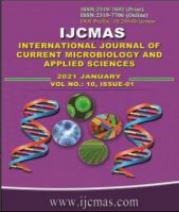


 National Academy of Agricultural Sciences (NAAS)
National Academy of Agricultural Sciences (NAAS)

|
PRINT ISSN : 2319-7692
Online ISSN : 2319-7706 Issues : 12 per year Publisher : Excellent Publishers Email : editorijcmas@gmail.com / submit@ijcmas.com Editor-in-chief: Dr.M.Prakash Index Copernicus ICV 2018: 95.39 NAAS RATING 2020: 5.38 |
A field experiment entitled “Effect of fly ash and phosphorus on growth and yield of Bt cotton (Gossypium hirustum L.)” was conducted during kharif 2018 at Research Farm, Guru Kashi University, Talwandi Sabo, Bathinda (Punjab). The experiment was laid out in split plot design comprising two fly ash doses viz., control (0 t/ha) and 10 t/ha in main plots and four doses of phosphorous viz., 0, 20, 30 and 40 kg P2O5/ha kg/ha in sub plots. The results showed that the highest plant growth viz., dry matter production and leaf area index and yield attributing characters viz., number of sympodial branches/plant, number of bolls/plant and stalk yield was recorded in fly ash @ 10 t/ha which was significantly higher over the control. The higher seed cotton yield was recorded with the application of fly ash @ 10 t/ha which was significantly higher over the control. With application of fly ash recorded 6.62% more seed cotton yield than control. Phosphorous @ 40 kg P2O5/ha recorded the highest plant height, dry matter, leaf area index, number of sympodial branches/plant, boll weight and stalk yield which was statistically at par with 30 kg P2O5/ha and was significantly higher than control (0 kg P2O5/ha) and 20 kg P2O5/ha. The highest seed cotton yield (19.2 q/ha) was obtained in 40 kg P2O5/ha which was significantly higher than other phosphorous levels viz., 0 kg P2O5/ha (9.9 q/ha) and 20 kg P2O5/ha (15.2 q/ha), but it was statistically at par with 30 kg P2O5/ha (18.1 q/ha). Phosphorous @ 30 kg P2O5/ha and 40 kg P2O5/ha recorded 82.8 and 93.9%, respectively higher seed cotton yield than 0 kg P2O5/ha in Bt cotton.
 |
 |
 |
 |
 |